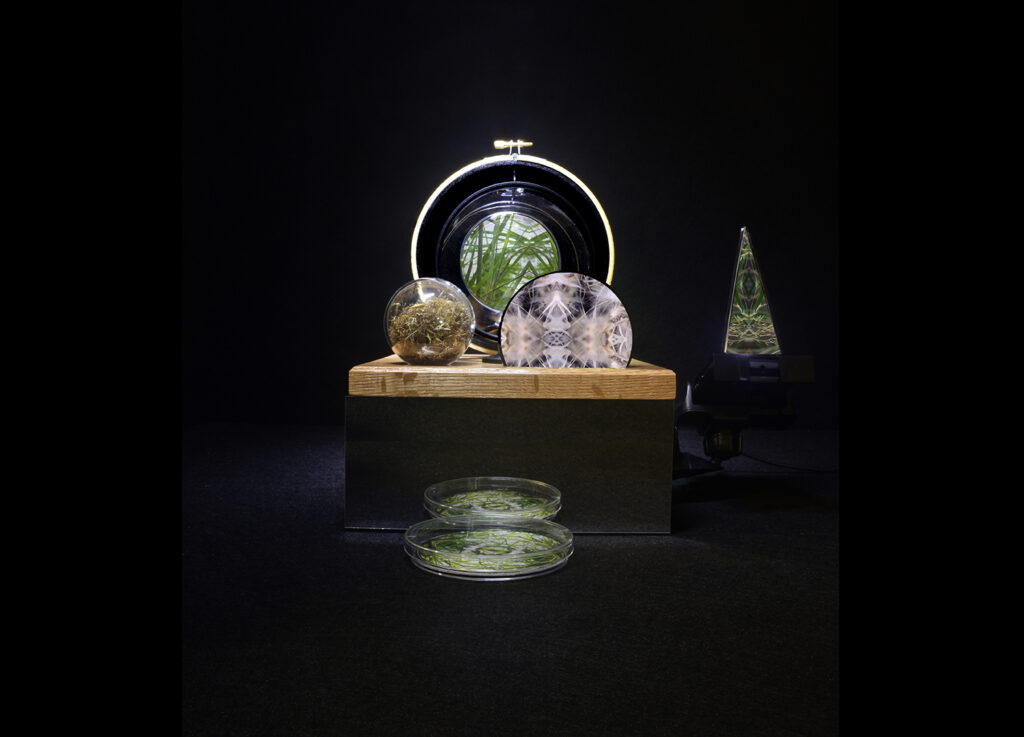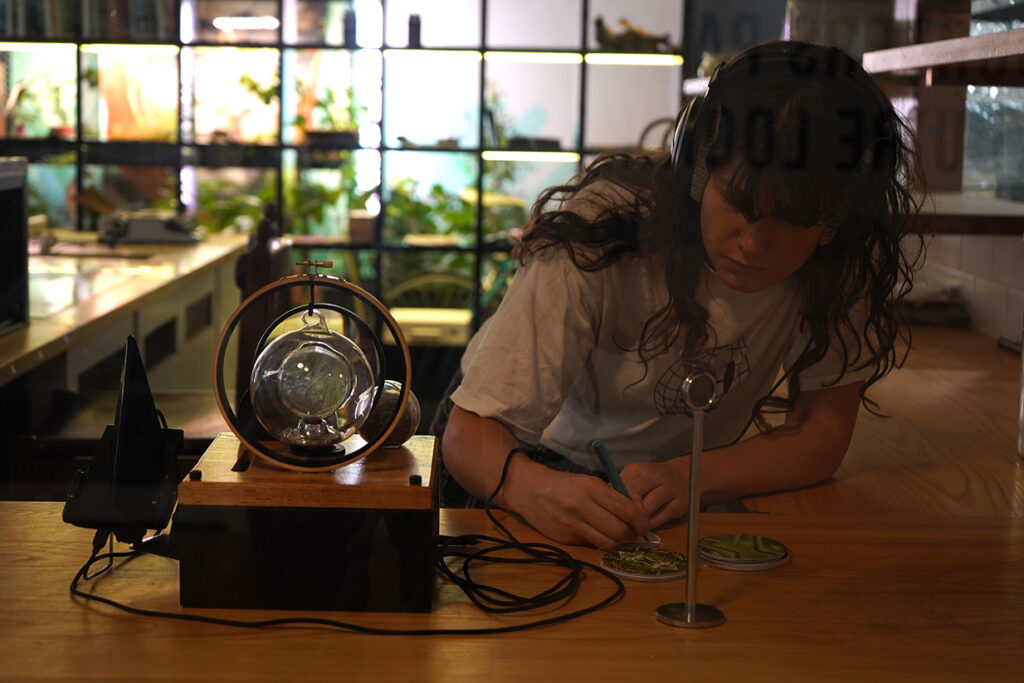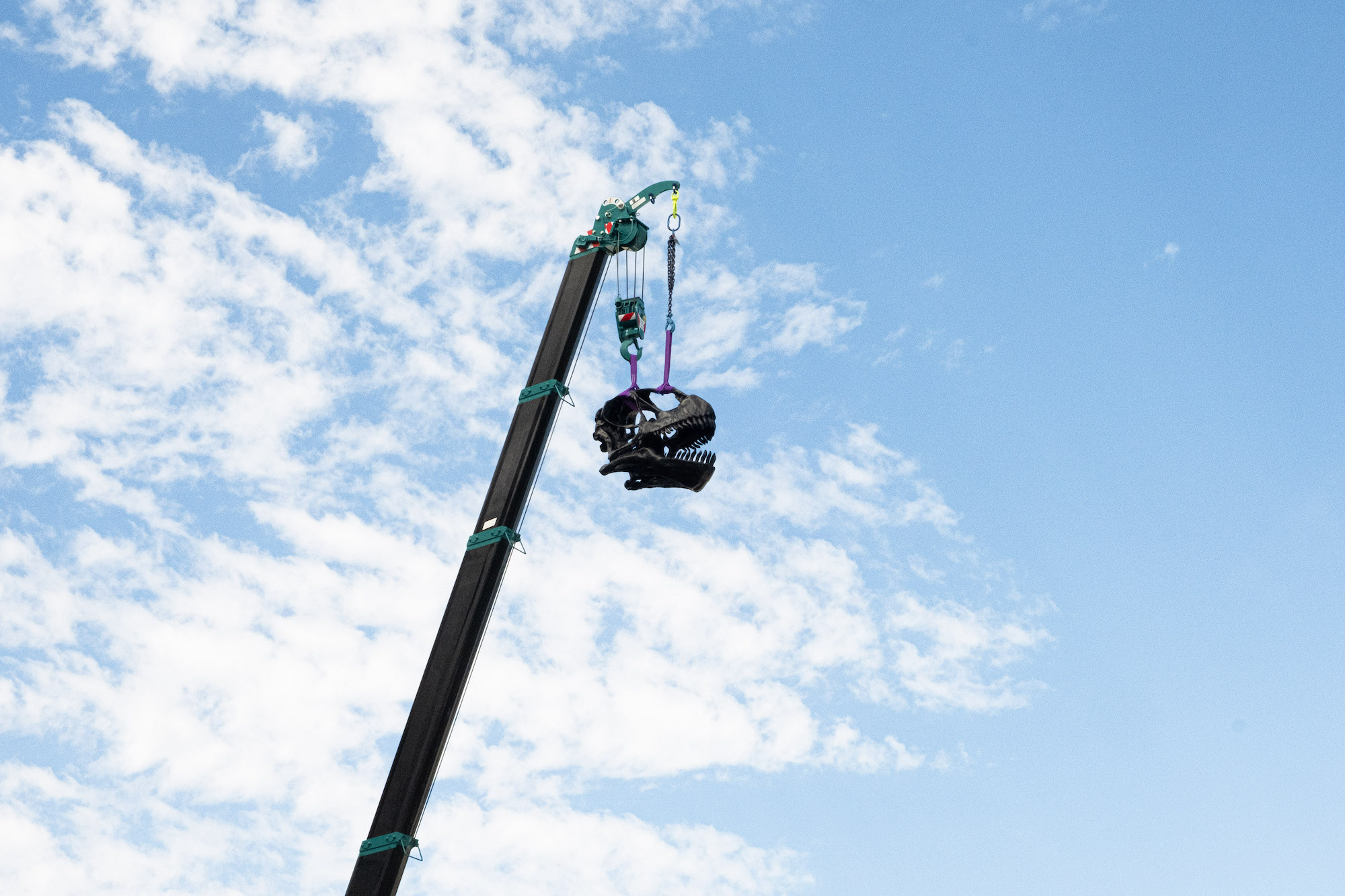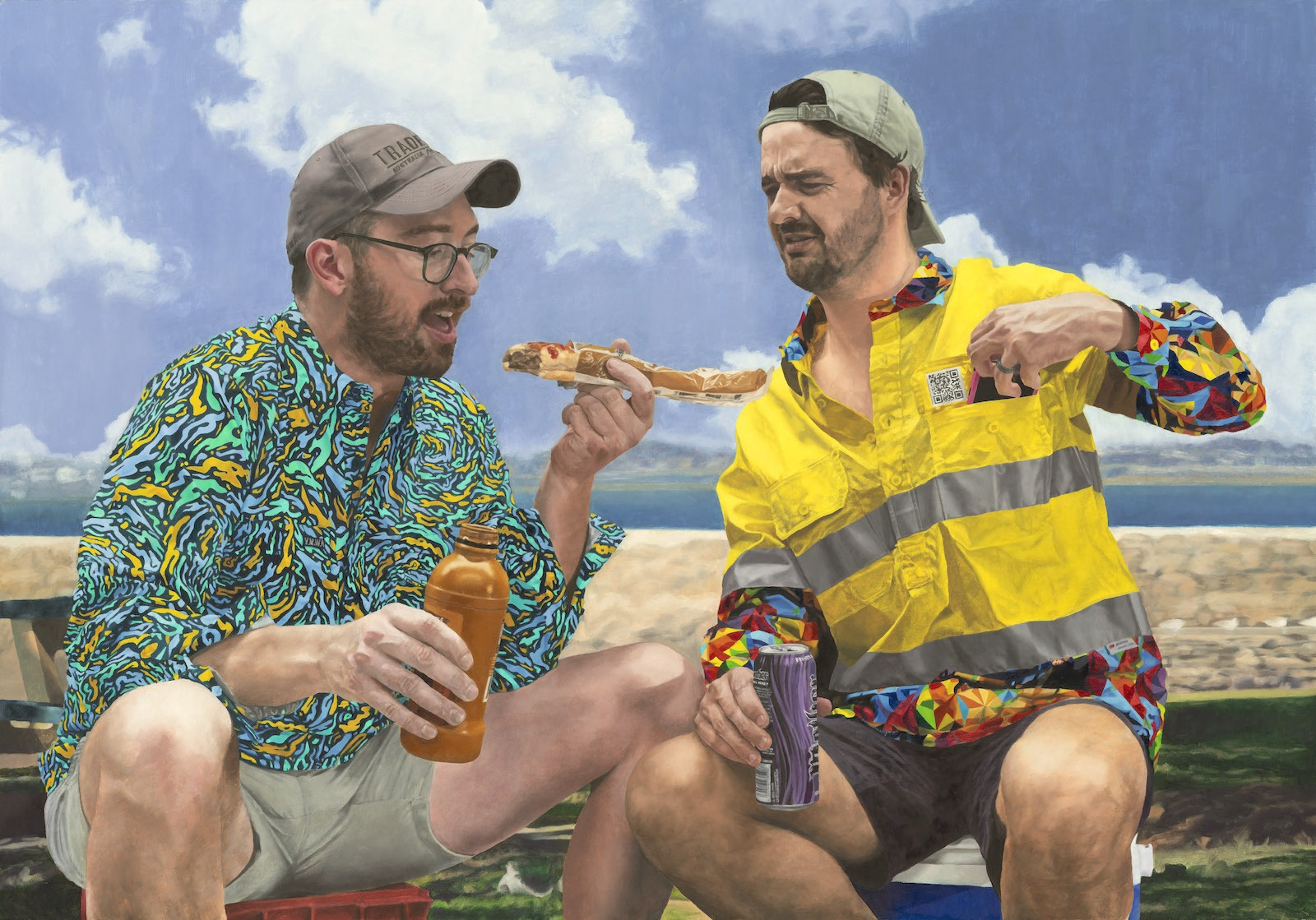
Carbon_Dating is more than an exhibition – it’s a research program, a space for creative collaboration, a multi-disciplinary intercultural dialogue, and a pathway toward activating positive, sustainable futures.1 Carbon_Dating’s artworks explore human relationships with Australian native grasses through a diverse array of media, emerging from a four-year project initiated by environmental artist Keith Armstrong. Elegantly curated by Beth Jackson and First Nations Curator and cultural advisor Jo-Anne Driessens (Guwa-Koa, Kuku Yalanji), the artworks draw attention to six endangered species of grass, the vulnerability of ecosystems under threat, and cultivating new and ancient ways of thinking about human-nonhuman relationships.

Personal Interweaver, Carbon_Dating Project Team, 2022, mixed media interactive sculpture: video, audio, grass card provocations, timber, glass, acrylic, mirror, digital frame, pen, grass seed. Video and tech design by Keith Armstrong, sound design by Luke Lickfold, Grass Card provocations by Daniele Constance, object design and construction by Donna Davis. Image: Donna Davis.
As a whole, the project strengthens exchange between settler and Indigenous Australian aesthetics, ways of approaching the arts and sciences, and being in the world. In doing so, Carbon_Dating highlights failures of our contemporary economic systems in which human survival is prioritised, dependent upon commodifying other organisms, treating them as capital to be extracted, thereby destroying Earth’s biosphere. The project and the exhibition together resist extractive capitalism, by asking the question: How might we work creatively to preserve and extend the social and environmental assemblages that have kept Earth habitable for so long? As artist participants in the project have stated: at this moment in time, whenever a discussion of environmental healing, remedy, or sustainability takes place, the experience and knowledge of Indigenous standpoints of Country and Culture must be engaged in order to secure meaningful change. With this in mind, First Nations Curator Freja Carmichael, a Ngugi woman belonging to the Quandamooka people, who consulted early on in the project, identified that grasses must be considered within living ecologies of mutual support, and not separated out from their environment (as in Western science regimes). Such Indigenous relational science and aesthetics are further linked in the project’s approach to planting and teaching about grasses in regional communities where the exhibition is shown, further expanding the project’s relational ethos.
At its core, Carbon_Dating draws attention to both social and ecological arrangements – spanning across space and time. Delissa Walker Ngadijina’s The Native Fence (2023) sets the tone for the exhibition. A wall sculpture woven from black spear grass, barbed wire grass, and scented top grass, Native Fence intertwines endurance with fragility. Physically resilient yet increasingly threatened, its component grasses form a softened, flowing grid dictated by the organic flexibility of the grass blades. Walker, a master weaver of Kuku Yalanji descent, poetically reminds us that within their organic entanglement with climates, other creatures, soils, water, microbes and unlimited denizens of the biosphere (both living and nonliving), plants are agential collaborators in larger, always changing ecological webs. Walker’s Native Fence subverts colonial notions of land ownership and boundaries, asking us to rethink our relationships with our biospheric collaborators. Here, the fence can be seen not as a barrier but a connector—an ephemeral structure that challenges the idea of property, dominance, and the power to “keep out” bodies and things.

Kilagi Nielsen’s Fascinator (2023), woven from kangaroo grass and Lomandra, further extends Walker’s strategy of decolonising settler symbology (fence, fascinator) by astutely replacing settler materiality (e.g., steel, plastic, fabric) with natural fibres. Styled like a Melbourne Cup hairpiece, Fascinator resists modes of splashy high fashion and consumer culture while making a statement about what kinds of materials are deemed efficient, valuable, or beautiful, and by whom. Nielsen, a master weaver from Papua New Guinea, has stated that she “made a deliberate choice to retain the seed heads of the kangaroo grass… to showcase the complete growth process… [and] to invite the viewer to contemplate the life cycle and transformation of the grass.”2 Thus, the artist gives value to the grass as it was once alive, capable of reproduction, acting as food source and ecological partner, and not merely a useful tool to get a job done – or a substance with which to make money.
A striking aspect of Carbon_Dating is its recognition of plant blindness, our human tendency to overlook plants and minimise their importance in our lives. This is perhaps most powerfully demonstrated in Donna Davis’ The Interweaver(s) (2019-2023), a series of techno-material sculptures connecting each artist/grass carer team by Wi-Fi to the project’s dispersed participants in the Grassland Community of Care.3 This apparatus, with its sci-fi aesthetic, is an “interspecies communication device,” created by Davis to facilitate everyday, deep engagement by each team with the grasses, to provoke artists’ curiosity, and to overcome their own plant blindness through visuals, sound, and science.4 The Interweaver(s) relays a broadcast composed by sound artist Luke Lickfold. His recordings of the grass-scape in Samford include birds, insects, and algorithmic renderings of on-site climate readings (that change according to humidity, wind speed, and rainfall, as read by the weather station designed and built by Armstrong).5 Timelapse video imagery of grasses from Samford, intermittently mediated through an optical kaleidoscope effect, provided visual connection to and information about the grasses. Daniele Constance’s circular prompt cards asked questions such as, “What is your earliest memory of grass?” or, “How do you introduce yourself to another living entity when spoken language may not be shared?” The Interweaver(s) support Carbon_Dating’s resonance with multispecies theorist Donna Haraway’s eco-restorative notion of “making kin” with nonhumans.6 That is, Haraway’s ardent call for projects combining art and science to reach out for knowledges beyond the human, echoes throughout the project, as it stays with the trouble of creating new mechanisms for kinship between humans and more-than-human worlds.
Keith Armstrong’s Grassland Community of Care (More Than Human Persons) (2023) is a lyrical video portrait inviting viewers to consider grasses as subjects. With the camera focusing tightly on intricate details of plants’ delicate structures, the film highlights their vitality and interconnectedness within micro and macro scales. We see insects move along the stems of grass, reminding us of complex lives dependent upon these plants. The camera shows us grasses’ tiny flowers and fuzzy seeds, attributes normally beyond our range of sight or interest, yet familiar to a ladybug. Clearly, Grassland Community of Care (More Than Human Persons) anticipates contemporary social science explorations into subjectivity, particularly the idea that dominant models are insufficient to address complex social, cultural, and environmental challenges. Armstrong’s video evokes an encounter with unfamiliar ontological universes, expanding our understanding of subjectivity. Relatedly, sociologist Maria Hynes’ and cultural geographer Scott Sharpe’s notion of “cosmic subjectivity” further contextualizes this work.7 Cosmic subjectivity theorises a mode of being that embraces the multiplicity of existential rhythms and processes, rejecting static or universalized notions of subjectivity. Armstrong’s video, which also intersperses short, poetic texts such as, “A unity of conversation through two clearly differentiated voices,” invites us to consider dynamic, immanent processes of life beyond human dominance, where agency is mutual with the more-than-human world.

Each artwork in Carbon_Dating contributes to a larger conversation about ecological care, gently urging viewers to consider alternative ways to relate to plants. Yet, amidst this reflection on ecological fragility, Carbon_Dating offers a sense of optimism. The project is not merely an art exhibition but a community effort, involving over 200 participants. Additional artists include Liz Capelin, Hilary Coulter, Merinda Davies, Mia Hacker, Andrea Higgins, Jason Murphy, Pipier Weller, Sasha Parlett, Melissa Stannard, and poet Brian Warner.8 This collective action transforms viewing into an active engagement, providing a model for how art can inspire collaboration with our biospheric neighbours.
In Carbon_Dating, the grasses become protagonists in their own right—their endurance over millennia a reminder of what is possible when we nurture the Earth rather than exploit it. Carbon_Dating resists the despair that often surrounds conversations about environmental challenges, offering instead a hopeful vision of ecological renewal. It argues that the solutions to our current crises lie not only in science or technology but in rethinking our relationships to each other – human and nonhuman.
- I visited the exhibition at Redlands Gallery, Cleveland. At the time of writing, Carbon_Dating is on view at Caloundra Regional Gallery from 18 October – 8 December, 2024. The exhibition schedule is available at https://www.carbondating.art/live/exhibition. ↩︎
- Kilagi Nielsen, Carbon_Dating catalogue, page 26. ↩︎
- The project’s Grassland Community of Care includes artists, scientists, grass carers, The Samford Ecological Research Facility, and the various regional art galleries where Carbon_Dating has been shown. Each artist/carer team is situated in one of seven Queensland regions. ↩︎
- Donna Davis, in conversation with the author, 7 October, 2024. ↩︎
- A short, fascinating video describing how artists/grass carers think about and use the Interweaver(s) can be viewed at https://www.carbondating.art/live/about. ↩︎
- Donna Haraway, Staying with the Trouble: Making Kin in the Cthuluscene (Durham: Duke University Press, 2016). ↩︎
- Maria Hynes and Scott Sharpe, “Cosmic Subjectivity: Guattari and the Production of Subjective Cartographies”, Area, Royal Geographic Society, Volume 53, Issue 2, June 2021. ↩︎
- See Carbon_Dating’s excellent catalogue and the project website for full information about all of the artists’ works. ↩︎
Carol Schwarzman is a visual artist and arts writer based in Meanjin/Brisbane. She is currently a PhD candidate at University of Queensland.



